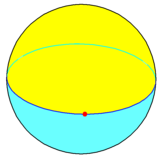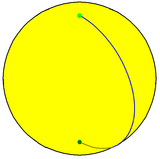Monogon
Appearance
| Monogon | |
|---|---|
 On a circle, amonogonis atessellationwith a single vertex, and one 360-degree arc edge. | |
| Type | Regular polygon |
| Edgesandvertices | 1 |
| Schläfli symbol | {1} orh{2} |
| Coxeter–Dynkin diagrams | |
| Symmetry group | [ ], Cs |
| Dual polygon | Self-dual |
Ingeometry,amonogon,also known as ahenagon,is apolygonwith oneedgeand onevertex.It hasSchläfli symbol{1}.[1]
In Euclidean geometry[edit]
InEuclidean geometryamonogonis adegeneratepolygon because its endpoints must coincide, unlike any Euclidean line segment. Most definitions of a polygon in Euclidean geometry do not admit the monogon.
In spherical geometry[edit]
Inspherical geometry,a monogon can be constructed as a vertex on agreat circle(equator). This forms adihedron,{1,2}, with twohemisphericalmonogonal faces which share one 360° edge and one vertex. Its dual, ahosohedron,{2,1} has twoantipodalvertices at the poles, one 360°luneface, and one edge (meridian) between the two vertices.[1]
 Monogonaldihedron,{1,2} |
 Monogonalhosohedron,{2,1} |
See also[edit]
Look upmonogonin Wiktionary, the free dictionary.
References[edit]
- Herbert Busemann,The geometry of geodesics. New York, Academic Press, 1955
- Coxeter, H.S.M;Regular Polytopes(third edition). Dover Publications Inc.ISBN0-486-61480-8
